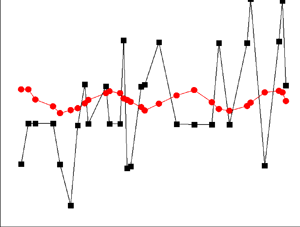Motion analysis of human biorhythm based on cosine model
DOI:
https://doi.org/10.3103/S0735272720060035Keywords:
cosine model, biological rhythm, movement, TSA calculation methodAbstract
Since ancient times, human beings began to understand the periodicity of their own activities. In modern times, people gradually found that the movement of living matter followed a specific space-time law and put forward the concept of biological rhythm. The biological rhythm of human body is a cycle theory that takes the body of each person as a research object and reveals the laws of physical strength, emotion and intelligence of human body. Based on this concept, this paper carries out a detailed analysis and discussion on the athlete biological rhythm, proposes a new human biological rhythm calculation method called cosine model method. The results are obtained by observing athletes for a period of time. According to the inherent tri-rhythm of human body using the description, statistics and analysis, a mathematical model is established to objectively and quantitatively describe the characteristics of biological data. That allows us to predict biorhythms.References
- J. Wang, S. Zhu, H. Wang, Y. Cai, Z. Li, “Second-order statistics of a radially polarized cosine-Gaussian correlated Schell-model beam in anisotropic turbulence,” Opt. Express, vol. 24, no. 11, pp. 11626–11639, 2016, doi: https://doi.org/10.1364/OE.24.011626.
- F. Arab, M. Omidvari, A. A. Nasiripour, “Investigating of the effect of biorhythm on work-related accidents - health and safety at work,” J. Heal. Saf. Work, vol. 4, no. 2, pp. 51–58, 2014, uri: https://jhsw.tums.ac.ir/article-1-5146-en.html.
- A. Van den Broeck, D. L. Ferris, C.-H. Chang, C. C. Rosen, “A review of self-determination theory’s basic psychological needs at work,” J. Manag., vol. 42, no. 5, pp. 1195–1229, 2016, doi: https://doi.org/10.1177/0149206316632058.
- W. Wilczynski, D. I. Lutterschmidt, “Biological rhythms: melatonin shapes the space-time continuum of social communication,” Curr. Biol., vol. 26, no. 19, pp. R892–R895, 2016, doi: https://doi.org/10.1016/j.cub.2016.08.045.
- T. C. Mondin et al., “Mood disorders and biological rhythms in young adults: A large population-based study,” J. Psychiatr. Res., vol. 84, pp. 98–104, 2017, doi: https://doi.org/10.1016/j.jpsychires.2016.09.030.
- M. Aksu, “Sleep and biological rhythms in 2015,”Sleep Biol. Rhythm., vol. 13, no. 1, pp. 1–1, 2015, doi: https://doi.org/10.1111/sbr.12104.
- R. L. Sack, R. W. Brandes, A. R. Kendall, A. J. Lewy, “Entrainment of free-running circadian rhythms by melatonin in blind people,” New Engl. J. Med., vol. 343, no. 15, pp. 1070–1077, 2000, doi: https://doi.org/10.1056/NEJM200010123431503.
- Z.-G. Zheng, “Deciphering biological clocks, and reconstructing life rhythms,” Physics, vol. 46, no. 12, pp. 802–808, 2017, doi: https://doi.org/10.7693/WL20171203.
- C. Chen et al., “Drosophila ionotropic receptor 25a mediates circadian clock resetting by temperature,” Nature, vol. 527, no. 7579, pp. 516–520, 2015, doi: https://doi.org/10.1038/nature16148.
- R. V. Puram et al., “Core circadian clock genes regulate leukemia stem cells in AML,” Cell, vol. 165, no. 2, pp. 303–316, 2016, doi: https://doi.org/10.1016/j.cell.2016.03.015.
- R. J. Oakenfull, S. J. Davis, “Shining a light on the Arabidopsis circadian clock,” Plant, Cell Environ., vol. 40, no. 11, pp. 2571–2585, 2017, doi: https://doi.org/10.1111/pce.13033.
- N. D. Bunyatyan et al., “Influence of human biorhythms on the blood glucose level and the efficacy of hypoglycemic drugs (review),” Pharm. Chem. J., vol. 51, no. 5, pp. 399–401, 2017, doi: https://doi.org/10.1007/s11094-017-1621-4.
- S. Christou et al., “Circadian regulation in human white adipose tissue revealed by transcriptome and metabolic network analysis,” Sci. Reports, vol. 9, no. 1, pp. 1–12, 2019, doi: https://doi.org/10.1038/s41598-019-39668-3.
- A. V. Akimov, A. A. Sirota, “Synthesis and analysis of algorithms for digital signal recognition in conditions of deforming distortions and additive noise,” Radioelectron. Commun. Syst., vol. 60, no. 10, pp. 458–468, 2017, doi: https://doi.org/10.3103/S0735272717100041.
- L. Molcan, H. Sutovska, M. Okuliarova, T. Senko, L. Krskova, M. Zeman, “Dim light at night attenuates circadian rhythms in the cardiovascular system and suppresses melatonin in rats,” Life Sci., vol. 231, p. 116568, 2019, doi: https://doi.org/10.1016/j.lfs.2019.116568.
- A. J. Fisher, H. G. Bosley, “Identifying the presence and timing of discrete mood states prior to therapy,” Behav. Res. Ther., vol. 128, p. 103596, 2020, doi: https://doi.org/10.1016/j.brat.2020.103596.
- T. Reilly, “A preliminary analysis of selected soccer skills,” Phys. Educ. Rev., vol. 6, no. 1, pp. 64–71, 1983.

Downloads
Published
2020-07-13
Issue
Section
Research Articles

